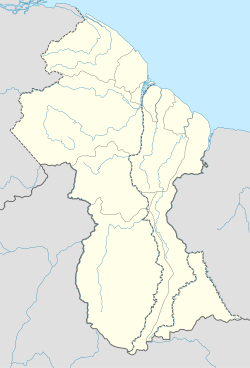Santa Mission
Santa Mission
Santa Aratak | |
|---|---|
Village | |
 | |
| Coordinates: 6°33′42″N 58°19′49″W / 6.5618°N 58.3304°W | |
| Country | |
| Region | Essequibo Islands-West Demerara |
| Settled | 1858[1] |
| Government | |
| • Toshao | Hilton Williams[2] |
| Area | |
• Total | 220 km2 (84 sq mi) |
| Population (2012)[4] | |
• Total | 277 |
Santa Mission (also: Santa Aratak[2] or Santa Aratack[5]) is a village in the Essequibo Islands-West Demerara Region of Guyana. Santa Mission is mainly inhabited by Lokono Amerindians.[1] The village is located on the Kamuni Creek, a tributary of the Demerara River.[6] The village of Hopetown, an early Chinese settlement, is located about 15 kilometres (9.3 mi) from Santa Mission.[7]
Overview
[edit]Santa Mission was founded in 1858 by Alfred Patterson, a lumberjack who was looking for Wallaba trees (Eperua falcata). The village is built on white sand hills along the blackwater Kamuni Creek.[1]
The economy of Santa Mission is based on tourism, craft making, and logging.[2] The village has a Nursery and Primary school,[1] a healthcare centre,[6] and a local library.[3] In 2008, the festivities of the Amerindian Heritage Month were held in Santa Mission.[3] As of 2015, it was the only indigenous village in Essequibo Islands-West Demerara with titled land.[1]
Sights
[edit]
Located on top of the hill is a giant silk-cotton tree. During the Dutch colonial era, the tree was used a navigation aid on the Demerara River. In the Lokono language, the tree is called Kamaka which means "mother of all trees."[1] There is a village monument dedicated to the past toshaos (village chiefs) and a kamuni Women Craft shop.[8] Near the village is the Arrowpoint Nature Resort, a privately owned tourist resort with its own nature reserve.[9]
Transport
[edit]Santa Mission does not have a connection to the road network and can only be accessed via the river.[1] Arrowpoint Nature Resort operates a ferry service from Timehri (Cheddi Jagan International Airport) which makes a stop at Santa Mission.[9] The journey will take between 45 minutes and one hour.[1]
Hopetown
[edit]In 1864, Chinese missionary O'Tye Kim petitioned the Court of Policy for a Chinese settlement.[10] In 1865, Hopetown was founded on the Kamuni Creek and started with 25 settlers. The village was named Hopetown after Admiral James Hope who had visited the village. It is located at 6°31′58″N 58°16′51″W / 6.53277°N 58.2808°W.[7]
Hopetown flourished and peaked at 800 people in 1874.[7] The economy was mainly based on charcoal production. When the demand dwindled, many Chinese moved to other towns.[11] By 1914, about a third of the population was non-Chinese and there were only 46 Chinese left.[7]
References
[edit]- ^ a b c d e f g h Mariah Lall (20 September 2015). "Santa Mission". Stabroek News. Retrieved 1 December 2021.
Santa Mission had just celebrated its 157th anniversary
- ^ a b c Ravena Gildharie (13 August 2017). "Santa/Aratak villagers driving community's tourism". Guyana Chronicle. Retrieved 1 December 2021.
- ^ a b c "Santa Aratak prepares for Heritage Day, 150th anniversary". 10 September 2008. Retrieved 1 December 2021.
- ^ "2012 Population by Village". Statistics Guyana. Retrieved 1 December 2021.
- ^ "Indigenous Villages". Ministry of Amerindian Affairs. Retrieved 1 December 2021.
- ^ a b "Santa Aratack …A tranquil slice of destination Guyana". Guyanese Online. 17 September 2018. Archived from the original on December 1, 2021. Retrieved 1 December 2021.
- ^ a b c d "The Hopetown Chinese settlement". Guyana Times International. 15 April 2016. Retrieved 4 December 2021.
- ^ "Santa Aratak Mission seeks slice of tourism pie". Department of Public Information. 19 September 2017. Retrieved 1 December 2021.
- ^ a b "Arrowpoint Nature Resort". Guyana Chronicle via Land of Six People. 18 July 2004. Retrieved 1 December 2021.
- ^ Tota C. Mangar (29 April 2004). "Background to the emergence of the Chinese settlement of Hopetown". Stabroek News via Land of Six People. Retrieved 4 December 2021.
- ^ "Hopetown". DevNet. Retrieved 4 December 2021.

